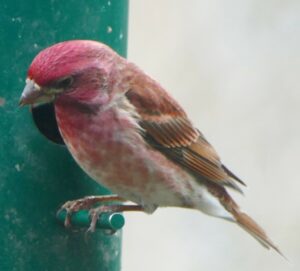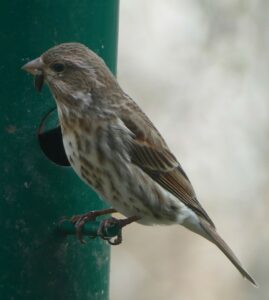Purple Finches and House Finches
How to tell them apart? For a long time, this was difficult for me. At first, I tried to rely on the color of the males – the male Purple Finch is more of a raspberry color and the male House Finch more of an orange-red. But what I discovered is that in winter when it is possible to see both birds at my feeders, this color difference is too subtle for me. In winter, the bright orange-red of the spring and summer male House Finch is duller and closer in shade to the raspberry of the Purple Finch. You may be better at color discernment than I am, but I had to find another way to tell these birds apart.
I now use two physical features to tell these males apart – and I use binoculars. I cannot see either of these features very well with just my eyes. The first is the breast and tummy area. The male Purple Finch has a shading of raspberry on the breast and it most often extends down into the tummy before it fades to a more pale/white. There may be some blurry brown streaks at the edges of the tummy area, but if they are there, they will be quite faint. Most times I do not see streaking at all. If you can get a close look, there is a faint mottling on the breast but most times, especially without binoculars, the breast will appear more clear/unmarked.


In contrast, the male House Finch has a shading of orange-red on its breast – and in the fall and winter, this can be more dull. Generally, this color does not extend as far into the tummy as the raspberry of the male Purple Finch. You should see some brown streaks on the House Finch’s pale tummy – most particularly at the edges where they will be more obvious. These streaks may be a bit blurry but you can distinguish them.

Before I talk about the second feature of these males that I look for, let me move to the females. In my opinion, female Purple Finches and female House Finches are easier to tell apart than their male counterparts. Although both are streaky brown birds, the female Purple Finch has a pale crescent behind each eye. Even though this crescent can look a bit tweedy, it does stand out. It is obvious – especially through binoculars. The female House Finch does not have this crescent. Her face and head are a bland, slightly tweedy brown. No distinguishing features.


Now back to the males. the second characteristic I look for is not as reliable as the streaking or lack of streaking on the breast and tummy – and is much more subtle. The male Purple Finch has that same crescent the female has – it is behind each eye. But instead of it being cream and a bit tweedy, it is solid raspberry. It is not easy to see with the naked eye but you can see it when you look at this male through binoculars. The male House Finch may or may not have a shape behind his eye – in his case, the color is orange-red. But if there is some sort of shape behind his eye, it will always be quite faint, and not the crescent the male Purple Finch has – and most often there is no shape behind the eye of the male House Finch.




If you are lucky enough to have males and females of both species at your feeders, watch their behavior. I think the females are easier to tell apart and if you observe these birds at your feeders for some minutes, the males the females stay closest to and interact the most with are most often their same species males.

